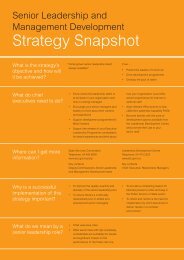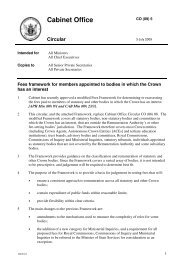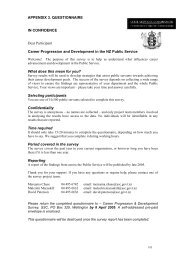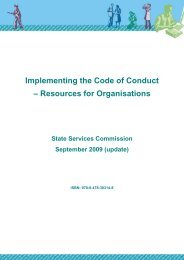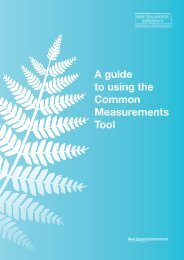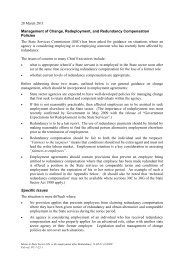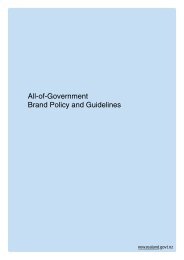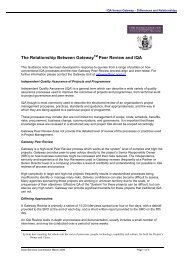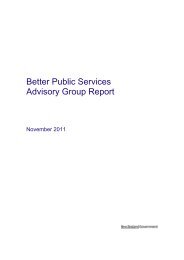NZ Report / Proposal Template - State Services Commission
NZ Report / Proposal Template - State Services Commission
NZ Report / Proposal Template - State Services Commission
You also want an ePaper? Increase the reach of your titles
YUMPU automatically turns print PDFs into web optimized ePapers that Google loves.
• From a practical perspective, and in the specific context of Spring Hill and Otago,<br />
the comment has been made to us by Department and contractor personnel that<br />
as the construction market grew tighter, there was less willingness on the part of<br />
the construction industry to enter into traditional fixed price contracts. The market<br />
was becoming a sellers market. Those in the market were increasingly being able<br />
to dictate their own terms and prices and this included, as noted earlier, a trend<br />
toward preferring CWA.<br />
5.59 In contrast to CWA, traditional <strong>NZ</strong>S 3910 approaches to procurement are suitable<br />
for projects where the scope and requirements of the project are well defined and where<br />
the risks are known, understood and capable of being appropriately factored into tender<br />
pric es . In our view, these characteristics are present across elements of the prisons<br />
construction programme and, accordingly, we do not consider that traditional forms of<br />
procurement should be automatically ruled out. Each project should be considered in its<br />
own rig ht and the business case made for preferring one form of procurement over others.<br />
5.60 On a related point, we consider that there are lessons arising from the Spring Hill<br />
and Otago projects in terms of how far down the supply chain to carry the CWA approach.<br />
As noted earlier, 95% of cost at Spring Hill is being incurred by CWA members. This is a<br />
very high ratio.<br />
5.61 CWA is management intensive. For those CWA members who are new to CWA,<br />
there is also a considerable learning curve and associated training requirements. The<br />
deeper CWA penetrates through the supply chain, the greater are the administrative and<br />
management overheads and at some point, the additional costs involved exceed the<br />
benefits that CWA might bring. In the case of Otago, we note that there are 17 CWA<br />
members. This is a large number of firms to manage. Where CWA is implemented, it<br />
makes sense to include the primary contractors as CWA members. However, application<br />
of CWA becomes increasingly questionable the further below this level the CWA seeks to<br />
probe. In our view, there may not be sufficient benefits over cost to drive down as far as<br />
the small and even medium sized businesses that supply trade services to the project.<br />
Selection Process<br />
5.62 Although not part of the original brief for this review, the <strong>Commission</strong> has<br />
requested that comment be made on the process for the selection and appointment of the<br />
main contractors involved with Spring Hill and Otago and the appointment of the Project<br />
Director and CMS (reflecting the key role that CMS has played in facilitating the CWA).<br />
5.63 In the case of Spring Hill, a Request for <strong>Proposal</strong> (RFP) for provider of building<br />
works was issued in September 2004 and Mainzeal was the preferred respondent. The<br />
Department and Mainzeal entered into a CWA Negotiation Framework Agreement (NFA)<br />
on 26 October 2004. Also in September 2004, the Department issued a RFP for building<br />
works in respect of Otago and Hawkins Construction was selected. A NFA with Hawkins<br />
was entered into also on 26 October 2004. The evaluation of the tenders was undertaken<br />
with particular focus on performance, culture and capability. Cost was not part of the<br />
evaluation criteria.<br />
5.64 The Department has documented procurement processes and tender procedures.<br />
The latest version of these is based on an original document prepared in 2002 and which,<br />
in turn, is based on the framework contained in the <strong>State</strong>ment of Good Practice issued by<br />
the Office of the Auditor General (that framework remains at the core of the current<br />
processes).<br />
Methodology and Processes: Design, Costing, Procurement and Scheduling 40




